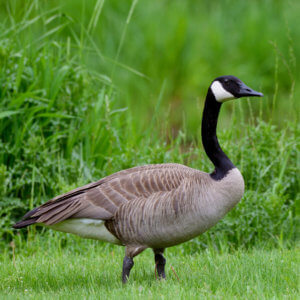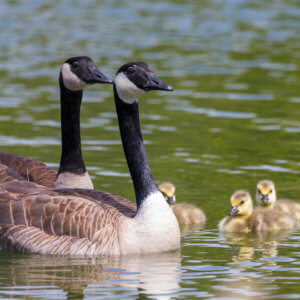Does it seem like geese are a year-round problem? You’re not wrong. Canadian geese in particular and their noisy honks are noticeable in the tri-state area on golf courses, around office buildings, and in parks throughout the year. While some are still migrating, milder winters – and in many cases, people feeding them – are keeping them around. But it’s way more complicated than that. What do Canadian geese eat? Sometimes whatever the public is feeding them. It can exacerbate the problem.
 Some species of geese never migrated in the first place. Some would just go as far as it took to get to fresh food and water – not necessarily for warmth. As of today, Canadian geese live in every state in the continental U.S. and every province in Canada. Their numbers have ballooned to about seven million in North America alone! In New Zealand and Europe, they are actually considered an invasive species.
Some species of geese never migrated in the first place. Some would just go as far as it took to get to fresh food and water – not necessarily for warmth. As of today, Canadian geese live in every state in the continental U.S. and every province in Canada. Their numbers have ballooned to about seven million in North America alone! In New Zealand and Europe, they are actually considered an invasive species.
Canadian geese migration has lowered, meaning Canadian geese have turned into residents instead of migrators, living where they are for a longer amount of time. Resident geese have shown that their chicks live longer and are safer from hunters and natural predators – which would explain the boom in population. They also have food and water sources and a large amount of area to roam. Why move?
If they have goslings, they are more likely to stay put, as well. When Canadian geese lay eggs, the females tend to nest in the same spot for multiple years. If they lose their eggs for some reason, they will most likely move on. Canadian geese behavior depends on the time of year. Male Canadian geese attack and will become extremely aggressive should you get near their nest of eggs. They are also pretty flexible. While a pond with lots of grass around it is ideal, should they have a nest of young, they will find a way to thrive wherever they are. And the answer to how long to Canadian geese live is vague. It can be anywhere from 10-24 years so if they come back year after year, that can be a long guest.
around it is ideal, should they have a nest of young, they will find a way to thrive wherever they are. And the answer to how long to Canadian geese live is vague. It can be anywhere from 10-24 years so if they come back year after year, that can be a long guest.
Not only are Canadian geese often aggressive, but their poop is also a health hazard, a slip-and-fall problem, and can pollute the water source. Remember in 2009, US Airways Flight 1549 struck a flock of Canada geese, forcing pilot Chesley “Sully” Sullenberger to land the plane on the Hudson River? It may not be a common issue, but it happened.
Because they are a federally protected species, you can’t get rid of Canadian geese. But there are ways to deter them from settling around your property. Trained dogs, noisemakers, and decoys that could scare the birds away have been used. Unfortunately, their efficacy isn’t exactly encouraging. You may be able to chase them away for a small amount of time – maybe even a couple of days – but your area was nice and hospitable to them before the dogs or noises came. They will come back to try again. A simple deterrent sprayed on the lawn can help way more than the other tactics since it will use something that causes minor intestinal distress. They won’t settle down where there’s no food. You can control geese, though.
One thing that has never changed is that geese are good for the environment. They provide several ecological benefits that may aid other plants and animals. They can serve as seed dispersers by eating plants in one area and then depositing seeds in another area through their feces. As part of the food chain, adult geese, goslings, and eggs provide food for animals such as foxes, snakes, raccoons, and turtles. Everyone has to eat!
No matter the reason geese are around your building, Canadian geese are a protected species in the United States and should be treated with respect. But they also never seem to leave. The negative impact they have on the landscaping and the people trying to get in the front door make it necessary to encourage them to move along. Since you can’t seem to rely on the cold weather to do it, you may want to call in the pros.